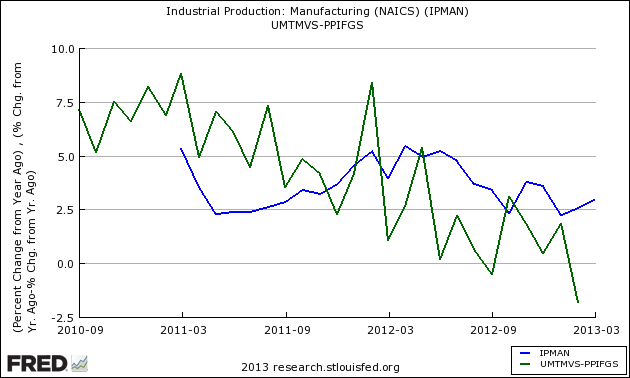The headlines say Industrial Production (IP) improved 0.4% in March 2013 and up 3.5% year-over-year. Econintersect‘s analysis using the unadjusted data is that IP was also showed improvement at an improvement of 0.8% month-over-month but the year-over-year was upa 3.2% year-over-year than the headlines.
- The year-over-year rate of growth is trending up using a three month rolling average, but is down using any rolling average between 6 to 12 months.
- Industrial production would have fallen in March if one ignores the large growth in utilities.
- The market was expecting a month-over-month increase of 0.3% to 0.4% (vs the headline growth decline of 0.4%).
- The manufacturing sub-index (which is more representative of economic activity) was down 0.1% month-over-month – and up 2.5% year-over-year – seasonally adjusted.
- This was a data reset month with the industrial production series undergoing its annual revision.

IP headline index has three parts – manufacturing, mining and utilities – manufacturing was down 0.1% this month (up 2.5% year-over-year), mining down 0.2% (up 3.8% year-over-year), and utilities were up 5.3% (up 10.5% year-over-year). Note that utilities are 10.3% of the industrial production index.
Comparing Seasonally Adjusted Year-over-Year Change of the Industrial Production Index (blue line) with Components Manufacturing (red line), Utilities (green line), and Mining (orange line)

The last eight months, unadjusted Industrial Production year-over-year growth has been between 2% and 4%. It is interesting that the unadjusted data is giving a smoother trend line.
Year-over-Year Change Total Industrial Production – Unadjusted

Economic downturns have been signaled by only watching the manufacturing portion of Industrial Production. Historically manufacturing year-over-year growth has been negative when a recession is imminent. This index is not indicating a recession is imminent.
Seasonally Adjusted Manufacturing Index of Industrial Production

Seasonally Adjusted Capacity Utilization – Year-over-Year Change – Seasonally Adjusted – Total Industry (blue line) and Manufacturing Only (red line)

Econintersect uses unadjusted data and graphs the data YoY in monthly groups. The difficulty in IP is that this index has not settled down to the New Normal effects making evaluation and analysis somewhat problematic.
Total Industrial Production – Unadjusted

Industrial production growth is NOT recessionary, and that the industrial portion of the USA economy is doing better than many other elements. Keep it real, here is a comparison between the survey predictions and the hard data. Industrial Production is the long blue bars.
Comparing Surveys to Hard Data

In the above graphic, hard data is the long bars, and surveys are the short bars. The arrows on the left side are the key to growth or contraction.
Caveats in the Use of Industrial Production Index
Industrial Production is a non-monetary index – and therefore inflation or other monetary adjustments are not necessary.
The monthly index values are normally revised many months after initial release and are subject to annual revision. The following graphic is an example of the variance between the original released value – and the current value of the index. Note that in general the current values are better than the original values – this is normally a sign of an improving economy.
Total Industrial Production – Unadjusted – Original Headline Index Value (blue line) and Current Index Value (red line)

This index is somewhat distorted by including utility production which is noisy, based primarily on weather variations.
There is some variance between the manufacturing component of industrial production which monitors production, and the US Census reported Manufacturing Sales. While it is true that these are slightly different pulse points (inventory not accounted in shipments) – they should not have different trends for long periods of time.
Comparing Year-over-Year Change – Manufacturing Industrial Production (blue line) to Inflation Adjusted Manufacturers Shipments (green line)

Econintersect determines the month-over-month change by subtracting the current month’s year-over-year change from the previous month’s year-over-year change. This is the best of the bad options available to determine month-over-month trends – as the preferred methodology would be to use multi-year data (but New Normal effects and the Great Recession distort historical data).
